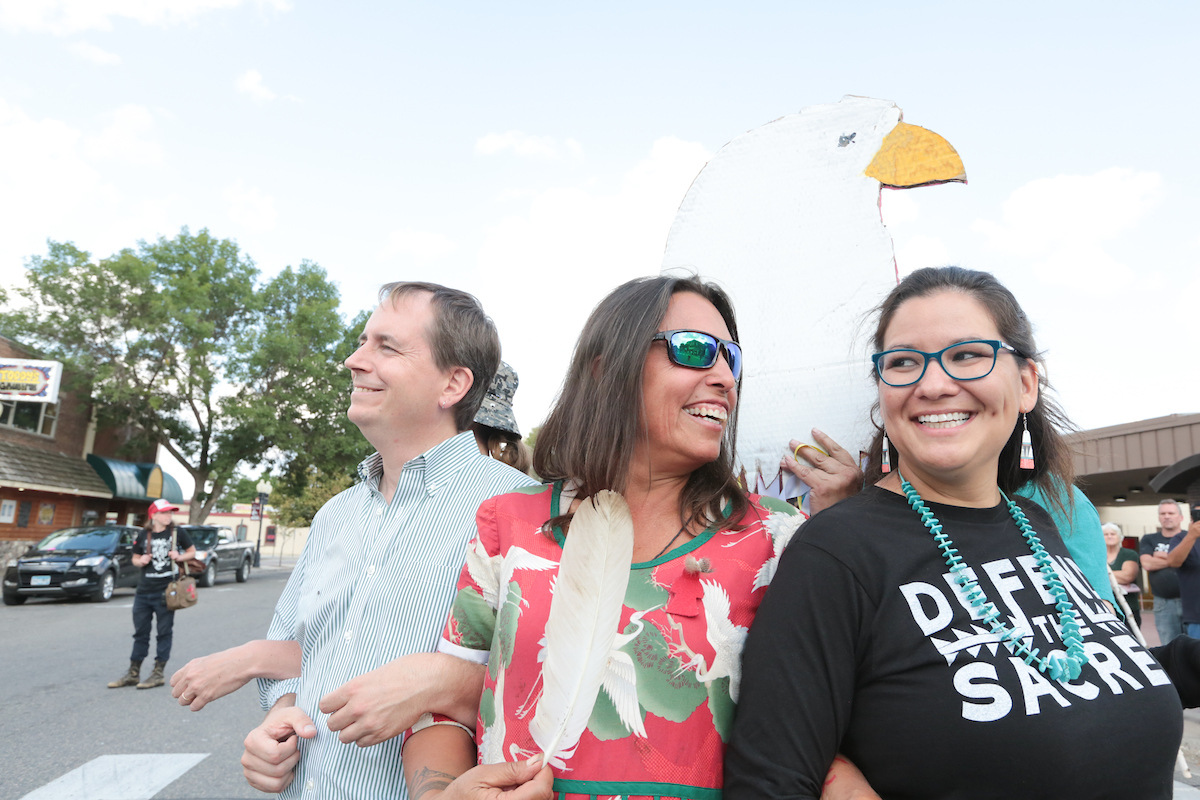“What should we do, folks? Stay, and risk arrest? Or leave, and risk our homeland?”
As I sat in the middle of an intersection in Bemidji, Minnesota, two weeks ago today, 26 of us grappled with this question. We were at an arrestable action to #StopLine3 -- one of only three such actions in Sierra Club history. And we had a big decision to make.
If built by Enbridge, Line 3 would be the one of the largest crude oil pipelines on this continent, carrying up to 915,000 barrels per day of one of the dirtiest fuel on earth -- tar sands crude. Line 3 would pass through lakes, wetlands, ancient wild rice beds, and the heart of Ojibwe treaty territory.
Back to that big decision. We had only moments to decide if we wanted to move along. I looked left and saw my near and dear friend, Winona LaDuke, with whom I’ve been fighting Enbridge pipelines since 2008. I looked right and saw Suzanne, my wife and member of the Leech Lake Band of Ojibwe. In that moment, it was abundantly clear to me all that was worth fighting for.
Being in Bemidji felt a bit like coming home, because for many years Northern Minnesota was my home. Suzanne and I lived not far from her family on the Leech Lake reservation for four years while I worked for Honor the Earth, fighting Enbridge. On this land, Suzanne had her naming ceremony, as well as healing ceremonies for her lupus, and water ceremonies at Mississippi headwaters. I participated in many of those ceremonies, smudging sage, praying, and listening to the Ojibwe Singers.
Suzanne’s family is well known on the reservation -- her grandmother, Dorothy Howard, was the oldest woman in the tribe at the time of her death four years ago. She was part of the Ojibwe Hymnal Singers and a familiar face to the pow wow circuit. Her grandfather was a World War II survivor and chairman of the Minnesota Chippewa Tribe for Anishinaabe peoples. In the years we lived there, we danced at pow wows, sugar bushed, went wild ricing, picked berries, and participated in other traditional practices and ceremonies. I’ve learned so much about Anishinaabe people from being part of this family and how they differ from my own tribe. This land and its peoples live in my heart, now and forever.
I am from a different Native community, the Diné people, and grew up frequently visiting family on the Navajo reservation. But there are many points of connection between my experience and Suzanne’s. Leech Lake, where Suzanne spent every summer growing up, is home to the St. Regis paper mill company -- one of earliest superfund sites in the nation. Suzanne’s family home was on what is now this Superfund site. My family’s home on the Navajo Nation is also home to one of the earliest superfund sites in U.S. history: the Church Rock uranium spill. Throughout U.S. history, Native lands and communities have been dumping grounds for pollution -- treated as energy sacrifice zones, disposable.

Which brings me back to sitting in the middle of that intersection in Bemidji, Minnesota. We were there to stop the next environmental disaster on Native land before it happens. For me, it was a moment of coming full circle. Ten years ago I was meeting with Ojibwe tribal councils about Enbridge’s pipeline plans and touring the site where their proposed pipeline would tear apart the land. There was a spill near Leech Lake shortly thereafter -- I remember seeing crude polluting pristine waters and its wildlife. In many ways, it was like coming home to stand shoulder to shoulder with Winona, with people like Marty Cobenais, Julia Nerbonne and Tom Goldtooth. But it was also heartbreaking to know that ten years later we are still fighting the same fight -- a tale all too familiar in Indian Country.
As I sat and thought about my decision whether to risk arrest that day, I remembered the words of Leech Lake chairman Faron Jackson, Sr. He said earlier this year: “The Lake Reservation will always be our home. Unlike a house, however, we can never rebuild or move if a disaster were to happen.”
I rose to my feet and told my friends and family all around me that I would stay. That I had to stay. Why? Because I have the privilege to leave.
My homeland is on the Navajo Nation. I can tweet about Line 3 all day long and I can call Governor Dayton to demand he stop the pipeline. But at the end of the day, I can walk away. The people who live at Leech Lake, the people who have since time immemorial known no other home -- they don’t have that same privilege.
Leech Lake is more than special -- it’s sacred and I’m committed to defending the sacred.
Leech Lake is home to one of the largest nesting areas of bald eagles in the U.S. It is home to the Anishinaabe people, who have been harvesting wild rice and maple syrup using traditional Ojibwe practices on this land for ten thousand years.
Line 3 endangers the Anishinaabe people who have been on this land since time immemorial. It endangers the ecosystems of wild rice, maple syrup, moccasin flowers, and chokecherries. It endangers the wildlife of muskrats, loons, walleye, and bald eagles. It endangers everything I hold sacred in this world and the next.
In case you’re wondering, I did choose to stay in the middle of that intersection. We will do what is necessary to protect the sacred because that’s what generations have done before us and what generations will need to do after us.
To join the fight against Line 3, sign this petition to tell Governor Dayton to halt the permits and any pre-construction until legal appeals have been heard, courts have weighed in, and the tribal cultural properties survey has been completed.
